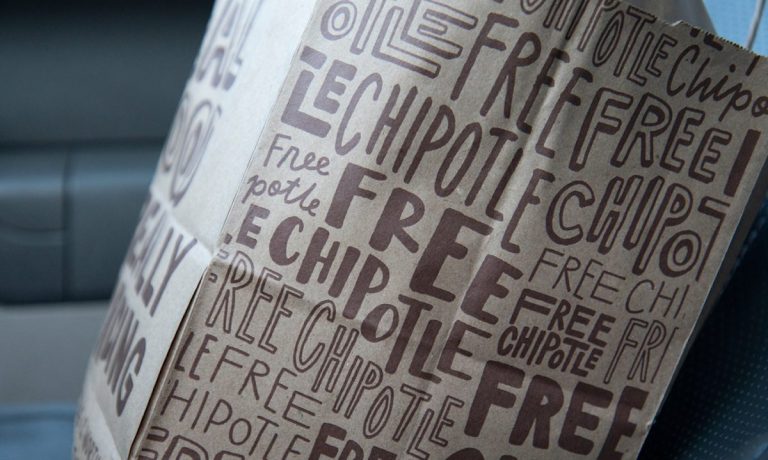
Where once even having a loyalty program was enough for a restaurant to stand out against the competition, now digital rewards are table stakes, which means brands need to find creative ways to build deeper relationships with their customers. While offering higher-value rewards is certainly appealing to consumers, a brand can only give away so many free foods or beverages before it becomes economically unfeasible.
Fast-casual chain Chipotle Mexican Grill, for one, has been trying out a new approach to loyalty that does not involve plying consumers with deals and freebies: rewards for rewards’ sake. Last month, the restaurant introduced achievement badges into its program, recognizing users for their engagement with the brand. The feature is part of the chain’s Extras platform, which features a range of gamified rewards options.
“We’re seeing an incredible increase in frequency with our Chipotle rewards members across the board — we now have over 23 million members in the program,” Nicole West, vice president of digital strategy and product at Chipotle, told PYMNTS in an interview. “I [have been surprised by] the excitement level for Extras, even when there’s no monetary value to them. Sometimes simply being rewarded for doing Chipotle the way you Chipotle is enough for our customers, and they get excited about that.”
West highlighted three areas of digital focus for the brand in the next 12 months: improving data use to personalize digital platforms, making the user experience increasingly frictionless with artificial intelligence (AI) and conversational commerce, and integrating digital technologies into the in-restaurant experience.
Up Close and Personal
The more consumers engage with rewards programs, the more those programs can drive loyalty — especially when a brand is smart about how it uses data. “I would say we’re really early innings on optimizing the data coming out of our Chipotle rewards program,” West said, adding that the Extras program is part of this push.
She noted that the program gives Chipotle insight into a given customer’s previous orders, their location, the times of day they come to the restaurant, and the kinds of messages and rewards that are most effective at bringing them back.
Even as the brand finds ways to boost loyalty without offering rewards with a cash value, discounts and free foods are still a valuable way to drive engagement. Research from the July/August edition of PYMNTS’ Delivering on Restaurant Rewards report, created in collaboration with Paytronix, found that 78% of restaurant customers want the opportunity to earn free food, and two-thirds want access to customized coupons or discounts.
Related news: Two-Thirds of Consumers Find Restaurant Rewards Impersonal
“We’re really excited about how the loyalty program can be a key enabler of our digital flywheel — using this data to enable increasingly personalized, relevant experiences to our members and our customers in general,” said West.
Talk to Me
The chain is looking to make its digital platforms as accessible and convenient as possible, West noted, counting voice- and messaging-based ordering systems among the ways the brand aims to create an increasingly frictionless experience.
“AI and automation can play a really cool role in enhancing the customer experience moving forward,” she said. “We’re testing ways that customers … can order and receive customer care via messaging services, via chatting through Pepper on our mobile app or website, and beginning to play around with voice automation as well.”
A PYMNTS survey of nearly 3,000 consumers found that nearly two-thirds of millennials and bridge millennials would be more likely to do business with a company that offered the ability to use voice commands to manage money or payments, and 45% of Gen Zers and 42% of Gen Xers said the same.
Additionally, research from PYMNTS’ report “The Bring-It-to-Me Economy,” created in collaboration with Carat from Fiserv, found that voice assistant users represent a huge opportunity for digital commerce. The study found that 89% of consumers who shop via voice assistant are ordering online more now than they did before the pandemic began, compared to just 52% of consumers who do not shop using voice assistants.
More details: Bring-It-to-Me Economy Ascends as Consumers Embrace Home-Centric Lifestyles
The Omnichannel Restaurant
West noted that the brand is interested in “using technology in the physical space to support new formats” and to “support the customer and crew member experience.”
As an example of a new format enabled by digital technology, she pointed to the restaurant’s Chipotlane model, which features drive-thru mobile order pickup lanes, describing this concept as the “digital drive-thru of the future.” She also highlighted the restaurant’s digital-only restaurant in Highland Falls, New York, featured in the December 2020 edition of the PYMNTS and Paytronix Order to Eat report, as well as the restaurant’s early forays into using digital makelines.
See also: Deep Dive: What Separated the Top Restaurants From the Rest in 2020
Overall, Chipotle has been a leader in its use of digital technologies. In the first half of 2021, for instance, digital orders represented about half of all sales. West attributes this success to the company’s focus on accessibility and convenience.
As she put it, “We’ve really set the North Star of a simple, easy, frictionless, digital customer experience, and we never compromise on that simplicity.”